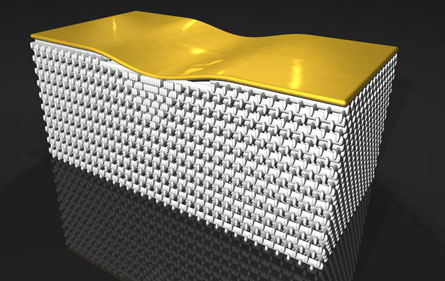 Physicists design an invisibility cloak that works from multiple points of view.
Physicists design an invisibility cloak that works from multiple points of view.Several cloaking devices that have emerged from the shadows in the last few years render objects invisible by bending light in ways it would never naturally go.
Invisibility cloaks are finally taking up some space. For the first time, scientists have built devices that can obscure objects in all three dimensions.
Several cloaking devices that have emerged from the shadows in the last few years render objects invisible by bending light in ways it would never naturally go. Beyond making things vanish, the devices could eventually have applications in computing, optics and mimicking general relativity on a lab bench.
But they have some glaring limitations. Unlike Harry Potter’s magic cloak, they don’t work for visible light, and until now, they worked only when viewed from a single angle — not terribly helpful for a stealthy spacecraft or a sneaky young wizard.
“If you look in plane the cloaking works quite nice,” says Tolga Ergin of the Karlsruhe Institute of Technology in
Ergin and his colleagues built a device that hides a bump in gold foil when viewed from straight above to an angle 30 degrees off vertical. It works for light with wavelengths of 1.4 micrometers and above, which, although ten times as long as visible wavelengths, makes this cloak among the closest to hiding things from human eyes. The researchers unveiled their device online in Science March 18.
“This is a huge step forward,” comments Vladimir Shalaev of
The device is an extension of a two-dimensional carpet cloak, a sheet of specially designed materials that when draped over an object, hides the resulting bump by steering light waves in the direction they would take if the object weren’t there. But until now, the bump was hidden only when viewed along the plane of the carpet. If the cloak could be scaled up to landscape size, for example, a person on the ground would see right through a hill, but climbing a ladder would reveal the feature.
Ergin and colleagues proved in 2009 that the same sort of device should work in three dimensions. Their design used a grid of polymer rods a few hundred nanometers thick stacked on top of each other like
To build the device, the researchers shined a laser onto a light-sensitive material called a photoresist. The photoresist hardened where the laser hit it, and the rest of the material was washed away, leaving the grid of polymer rods behind. This technique, called direct laser writing, is one of the most promising for extending cloaks to visible wavelengths, Shalaev says.
“The fabrication is absolutely spectacular,” he says. If scientists can improve direct laser writing so that the rods are thinner than the wavelength of visible light, the technique could be a relatively fast, cheap and simple way to build cloaks that really do hide things out of sight.
The biggest obstacle to reaching visible-wavelength cloaks has been how difficult they are to build, says David Smith of
And at the rate things are going, true invisibility cloaks might not be so far away. Another 3-D carpet cloak that works at longer wavelengths has been built by researchers at Northwestern University in Evanston, Ill. Cheng Sun and his colleagues announced their achievement online March 17, one day before Ergin’s paper was published — though Sun says Ergin’s group probably built their cloak first.
“Everyone is trying to get there first,” Sun says. “I think everyone will come up with a different, surprising way to get to the point.”
By Lisa Grossman

 Previous page
Previous page Back to top
Back to top







